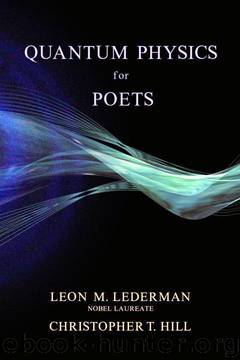Quantum Physics for Poets by Leon M. Lederman;Christopher T. Hill

Author:Leon M. Lederman;Christopher T. Hill [Leon M. Lederman;Christopher T. Hill]
Language: eng
Format: epub
Published: 2011-07-07T00:00:00+00:00
FIGURE 29: Chemistry in action. These are the three smallest members of the simplest family of hydrocarbons, called "aliphatic (in-line) hydrocarbons," methane, ethane, and propane. (The sequence continues with additional carbon atoms to butane, pentane, hexane, heptane, octane, nonane, decane, etc.)
We also know, emphatically, that two helium atoms do not combine. In fact, it is very difficult to get helium to react with anything. Why? Helium has a filled shell and therefore is standoffish and doesn't react chemically. Molecule formation is a "shell-filling" or "shell-completing" process, because filling a shell, even with a neighbor's electrons, generally makes a stable, lower-energy system. If you are borrowing the neighbor's electrons, you are, of course, capturing the neighbor in the process. Two hydrogen atoms combine so that their two electrons (one from each 1S orbital) fill a covalent 6 bond and, behold, the hydrogen molecule! Oxygen is short by two electrons to fill its shell, so it attracts two hydrogens to make that stuff with which we gargle and take our daily baths. Get the idea? You are now a budding chemist.
We suspect that there are millions of you out there for whom the mere mention of chemical bonds may evoke a nostalgic trip back to high school chemistry and to an era of intense, oscillating joy and despair, never again matched and where you learned nothing about quantum theory. Fortunately, now you can contemplate such things without distraction.
Chemical reactions take place so as to minimize the energy of the combined system. In the quantum theory, the energy is quantized and electrons arrange themselves so as to occupy the lowest energy state. The exclusion principle takes precedence over the quest for the state of lowest energy, resulting in the rule that the electron will "place itself' in the lowest state that does not overlap or impinge on the space of the other electrons.
Download
This site does not store any files on its server. We only index and link to content provided by other sites. Please contact the content providers to delete copyright contents if any and email us, we'll remove relevant links or contents immediately.
The Complete Stick Figure Physics Tutorials by Allen Sarah(7307)
Secrets of Antigravity Propulsion: Tesla, UFOs, and Classified Aerospace Technology by Ph.D. Paul A. Laviolette(5309)
Thing Explainer by Randall Munroe(3877)
The River of Consciousness by Oliver Sacks(3536)
The Order of Time by Carlo Rovelli(3145)
How To by Randall Munroe(3032)
A Brief History of Time by Stephen Hawking(2960)
I Live in the Future & Here's How It Works by Nick Bilton(2935)
The Great Unknown by Marcus du Sautoy(2646)
What If?: Serious Scientific Answers to Absurd Hypothetical Questions by Randall Munroe(2637)
Midnight in Chernobyl by Adam Higginbotham(2483)
Blockchain: Ultimate Step By Step Guide To Understanding Blockchain Technology, Bitcoin Creation, and the future of Money (Novice to Expert) by Keizer Söze(2445)
Networks: An Introduction by Newman Mark(2360)
The Meaning of it All by Richard Feynman(2299)
Easy Electronics by Charles Platt(2281)
The Tao of Physics by Fritjof Capra(2229)
Midnight in Chernobyl: The Untold Story of the World's Greatest Nuclear Disaster by Adam Higginbotham(2177)
When by Daniel H Pink(2082)
Introducing Relativity by Bruce Bassett(2076)
